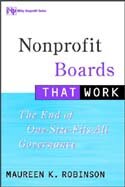Nonprofit Boards That Work: The End of One-Size-Fits-All Governance
Since the publication of John Carver's Boards that Make a Difference in 1990, much of the literature about nonprofit boards has been directed to supporting or debunking Carver's presentation of a universal governance model. The subtitle of Maureen Robinson's recent book (the end of one-size-fits-all governance) tips the reader to this author's view that whatever their similarities, nonprofits differ dramatically in terms of scale and structure, organizational history and cultural traditions. "A million nonprofits will arrive at almost as many variations in strategies for achieving good governance," Robinson writes. "Each Board must fit its performance to the needs of the organization it serves and be willing to change as the organization changes."
Particularly useful in this context is Robinson's differentiation of the board's role into three "dimensions": legal, functional, and symbolic. The legal dimension represents the board's fiduciary role and its stewardship duties. The functional dimension is the board's role in managing and delivering the organization's programs and services. The symbolic dimension comprises the board's role as an exemplar of the values and culture of the organization.
Thankfully, the author also sets out to correct any misapprehensions that governing a nonprofit organization is easy. While the theory of governance may be simple to grasp, implementation is difficult no matter what the size of the organization. Although the board is referred to as a unit, Robinson explains, it is actually a collection of individuals with their own unique reasons for being on the board and their own individual strengths and limitations. Quoting Cyril Houle, she concludes that "a good board is a victory, not a gift."
In the book's early chapters, Robinson discusses the value and roles of the board, and suggests strategies for managing meetings and structuring committees so that the board can focus on what she considers the essential elements of the work of all nonprofit boards: financial oversight, planning, evaluation, and fundraising.
Later chapters address the interpersonal dimensions of board-building: the role of the chairperson, the nature of the relationship with the executive director, recruitment, training, and evaluating board members.
Robinson writes in an engaging and personal style, and sprinkles examples and insights gained from her experience at the National Center for Nonprofit Boards, the Smithsonian Institution, and the American Association of Museums. Interspersed with the examples are many suggestions, mostly directed toward chairpersons and executive directors. Addressed to a relatively inexperienced reader, there is no trivialization of issues, nor condescension. Although relatively slim (176 pages), the book covers its subject quite well and is likely to be useful to anyone in a leadership role in a nonprofit organization or, alternatively, as a valuable addition to a nonprofit management curriculum.
Chapter Contents:
- Assigning Value: Do Boards Matter?
- Why One Size Won't Fit All
- Defining the Role of the Board
- Boards That Work: The Structure of the Work
- Boards That Work: The Substance of the Work
- Building Productivity through Board Culture
- A Working Partnership: The Executive Director and the Board
- Saying Yes Twice: Engaging the Individual Board Member
- Fine-Tuning the Instrument
- Closing Thoughts
For additional materials on this topic, refer to Literature of the Nonprofit Sector, using the subject terms "Board members" or "Board members — case studies".






